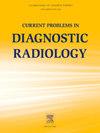将案例会议转化为同行学习:机会与障碍。
IF 1.5
Q3 RADIOLOGY, NUCLEAR MEDICINE & MEDICAL IMAGING
引用次数: 0
摘要
背景:我们假设来自每周一次病例会议的放射科的教师将有兴趣采用同伴学习会议来发展我们部门的同伴学习实践。材料和方法:腹部科自愿试行同伴学习,每月一次,代替每周的病例会议。该部门的一位同侪学习冠军领导了这个项目。完成了一项腹部科教师调查,以衡量对同伴学习的兴趣。结果:调查的回复率为81%:教师对在数据库中收集案例感到满意(47%),并且更喜欢通过聊天或电子邮件接收案例反馈;教师们倾向于将各种案例类型纳入同伴学习;教师们稍微倾向于有一个专门的同行学习会议负责人(35%),并指出部门教师的提交目标应该是每个教师每月一个案例(88%)。所有教师都指出了不责备文化的重要性,并且最喜欢匿名案例报告(70%)。尽管该科教师对同侪学习持积极态度,但由于缺乏与放射科医生工作流程的整合,以及无法将时间投入到教师作为同侪学习会议领导者的角色中,实施的技术部分代表了一个主要障碍。结论:在尝试实施同侪学习之前,我们的教员对同侪学习融入日常和每月的分工工作流程的关注需要得到解决。在高临床影像量的背景下,额外的努力,如使用病例提交工具和准备会议所需的时间,超过了我们环境中同行学习的整体感知价值。本文章由计算机程序翻译,如有差异,请以英文原文为准。
Converting case conferences to peer learning: Opportunities and barriers
Background
We hypothesized that faculty from a radiology division with weekly case conferences would be interested in adopting a peer learning meeting to grow the practice of peer learning in our department.
Materials and Methods
The Abdominal Division volunteered to pilot peer learning once a month in lieu of the weekly case conferences. A peer learning champion from the division took leadership for this project. An abdominal division faculty survey was completed to gauge interest in peer learning.
Results
The survey had an 81 % response rate: Faculty felt comfortable collecting cases in a database (47 %) and preferred receiving case feedback by chat or email; faculty favored a variety of case types for inclusion in peer learning; faculty slightly preferred having a dedicated peer learning conference leader (35 %) and indicated the submission target for the division faculty should be 1 case per month per faculty (88 %). All faculty indicated the importance of a no-blame culture and most favored anonymous case presentations (70 %). Despite the positive attitudes towards peer learning among the division faculty, the technical piece of the implementation represented a major barrier due to lack of integration into the radiologist workflow and inability to commit time to a faculty member's role as peer learning conference leader.
Conclusions
Our faculty members’ concerns regarding peer learning integration into the daily and monthly divisional workflow needed to be addressed before attempting to implement peer learning. In the context of high clinical imaging volumes, additional efforts, such as accessing case submission tools and time needed to prepare conferences, outweighed the overall perceived value of peer learning in our setting.
求助全文
通过发布文献求助,成功后即可免费获取论文全文。
去求助
来源期刊

Current Problems in Diagnostic Radiology
RADIOLOGY, NUCLEAR MEDICINE & MEDICAL IMAGING-
CiteScore
3.00
自引率
0.00%
发文量
113
审稿时长
46 days
期刊介绍:
Current Problems in Diagnostic Radiology covers important and controversial topics in radiology. Each issue presents important viewpoints from leading radiologists. High-quality reproductions of radiographs, CT scans, MR images, and sonograms clearly depict what is being described in each article. Also included are valuable updates relevant to other areas of practice, such as medical-legal issues or archiving systems. With new multi-topic format and image-intensive style, Current Problems in Diagnostic Radiology offers an outstanding, time-saving investigation into current topics most relevant to radiologists.
 求助内容:
求助内容: 应助结果提醒方式:
应助结果提醒方式:


